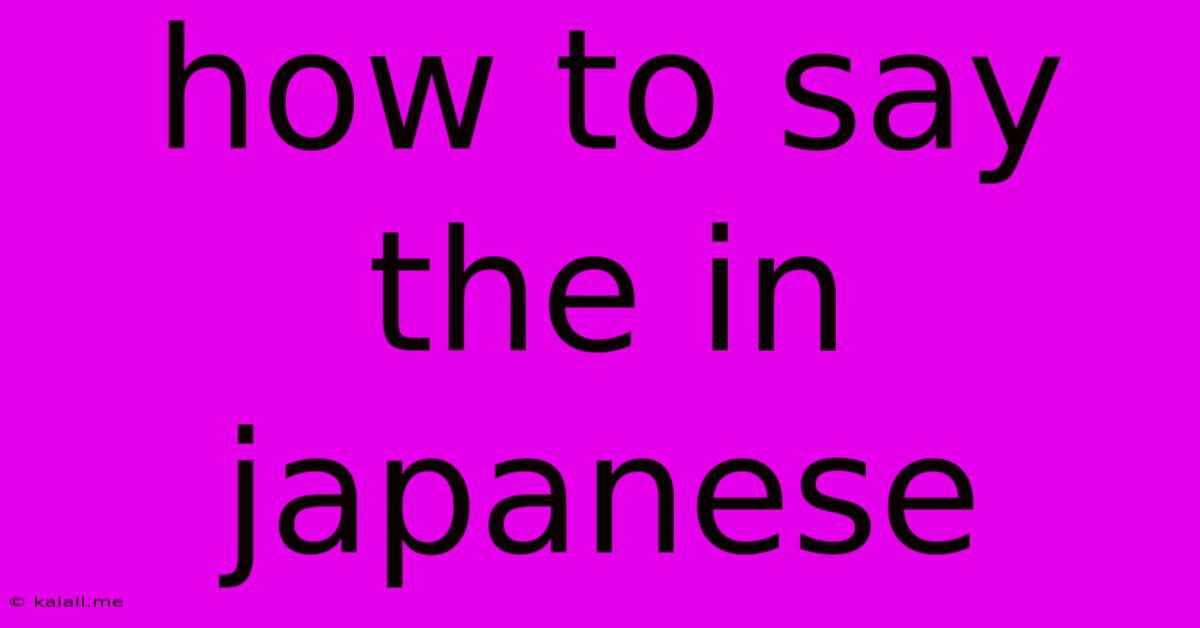How To Say The In Japanese
Kalali
May 19, 2025 · 3 min read

Table of Contents
How to Say "The" in Japanese: A Comprehensive Guide
This article will explore the fascinating nuances of expressing the concept of "the" in Japanese, a language that doesn't have a direct equivalent to the English definite article. Understanding how Japanese handles definiteness is crucial for accurate and natural-sounding communication. This guide provides a clear explanation of the various strategies used and offers practical examples to help you master this important aspect of Japanese grammar.
The Absence of a Direct Translation
Unlike English, which uses "the" to specify a particular noun, Japanese doesn't have a single word that serves this purpose. Instead, context, particles, and other grammatical elements work together to indicate definiteness. This means the way you express "the" depends heavily on the situation.
Key Strategies for Indicating Definiteness
Several methods are employed to convey the meaning of "the" in Japanese. Here are some of the most common:
-
Context: This is the most important factor. Often, the surrounding sentence or conversation makes the meaning clear without needing any specific word. For example, if you're talking about a specific object already mentioned, the listener will understand it's "the" object without additional markers.
-
Particles: Particles are small words that indicate grammatical function. While not direct translations of "the," particles like は (wa) and が (ga) can contribute to conveying definiteness. は (wa) marks the topic of the sentence, often implying familiarity or prior mention, while が (ga) marks the grammatical subject.
-
Demonstrative Pronouns: Words like この (kono – this), その (sono – that), and あの (ano – that over there) function similarly to "this" and "that" in English but can also indicate definiteness by pointing to a specific item.
-
Relative Clauses: Adding a relative clause to a noun provides more information and context, effectively making it specific and implying "the." This method is particularly useful for clarifying which specific noun you mean.
-
Previous Mention: As mentioned earlier, if a noun has already been introduced in the conversation, it's often understood to be "the" [noun] in subsequent references.
Examples in Context
Let's look at some examples to solidify your understanding:
Example 1: Contextual Definiteness
- English: The dog barked. (Assuming a previously mentioned dog)
- Japanese: 犬が吠えた。(inu ga hoe-ta) - The dog barked. (The context clarifies which dog)
Example 2: Using Particles
- English: The cat is sleeping.
- Japanese: 猫は寝ている。(neko wa nete iru) - The cat is sleeping. (は (wa) indicates the topic)
Example 3: Demonstrative Pronouns
- English: I saw the car. (Pointing to a specific car)
- Japanese: あの車は見た。(ano kuruma wa mita) - I saw that car. (あの (ano) specifies the car)
Example 4: Relative Clauses
- English: The book that I borrowed is interesting.
- Japanese: 僕が借りた本はおもしろい。(boku ga karita hon wa omoshiroi) - The book that I borrowed is interesting. (The relative clause clarifies which book)
Mastering the Nuances
It's important to remember that there isn't a one-size-fits-all answer. The best way to express "the" in Japanese depends entirely on the specific situation and surrounding context. Through practice and immersion in the language, you'll naturally develop a feel for how to use these different strategies effectively. Continue learning Japanese grammar, focusing on particles and sentence structure, to gain a better understanding of how definiteness is conveyed. Paying close attention to how native speakers use these elements in conversation will significantly aid your progress.
Latest Posts
Latest Posts
-
Is 2 The Only Even Prime Number
May 19, 2025
-
Is Rubbing Alcohol The Same As White Spirit
May 19, 2025
-
How Long Does It Take To Restore Icloud
May 19, 2025
-
On A Bus Or In A Bus
May 19, 2025
-
Spanish For Can I Have The Bill
May 19, 2025
Related Post
Thank you for visiting our website which covers about How To Say The In Japanese . We hope the information provided has been useful to you. Feel free to contact us if you have any questions or need further assistance. See you next time and don't miss to bookmark.